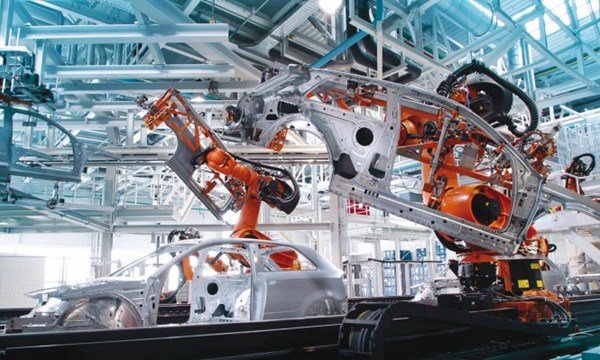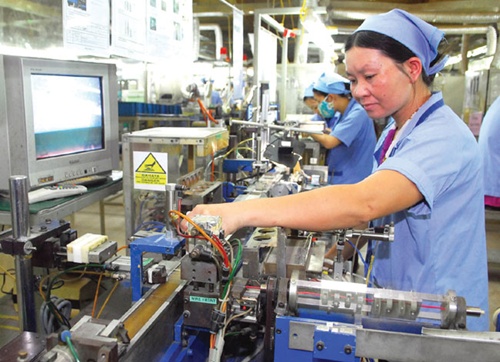When Vietnam replaces China as "a promised land"
When Vietnam replaces China as "a promised land"
The year 2014 marked one of the biggest events in recent years in the global economy: China’s hot growth in the three consecutive decades came to an end.

This means that the phenomenon of cash flow around the world to China over the past two decades has ended, and now the huge volume of capital is leaving the world's second-largest economy to look for a new promised land, which is Vietnam.
Economists in the world had raised this question very early: which country will attract most of the international investment after it is withdrawn from China, which has become an increasing trend since mid-2014, with hundreds of billions of US dollars withdrawn from the country.
As the Chinese economy is no longer the land of promise, as it has not maintained its biggest advantages - cheap labor and a huge market – staying in China has not brought about huge benefits to international investors. They will be looking for a new promised land, which offers the advantages of the Chinese economy 10-20 years ago. And that land is Vietnam.
Indeed, Vietnam at the present time has almost all of the advantages to attract foreign investors looking for a new headquarters after leaving China. It is a market with a population of nearly 100 million, with half of the population of working age. The labor costs are cheaper than most countries in the region.
And most importantly, with its convenient location of being situated near the world's busiest sea route in the world, Vietnam will be replacing China to become a dynamic economic center of the entire Asia Pacific region - which has the largest economies in Asia, such as China, Japan, South Korea and the ASEAN economies.
The economic potential of Vietnam at the present time cannot be refuted. In 2014, Vietnam surpassed all other countries in Southeast Asia to become the largest exporter to the US, though Vietnam has had the shortest time of economic relations with the US among the ASEAN countries. Vietnam’s economic potential has become so clear that international investors at the moment are realizing that an investment boom similar to what took place in China over 10 years ago is emerging again in Vietnam.
And the people who come late will be damaged. That is probably the reason why the total amount of foreign investment in Vietnam soared in late 2014, and it is forecasted to increase more rapidly in 2015, when the capital withdrawn from China will be increasing.
In fact, Vietnam at the present time could even surpass all the countries in the region to become the most attractive place for investment capital being withdrawn from China instead of the prediction that the capital flow will be scattered throughout the area. The advantages of Vietnam at the present time are much larger than other countries in Southeast Asia.
The first is the dominance of population and demographics. Vietnam is the third most populous country in Southeast Asia, with the highest proportion of the population of working age (nearly 50%) and a young population which is still in the golden population period - which is one of the most favorable conditions for economic development activities.
Another big advantage is that labor costs and costs in Vietnam are much cheaper than many countries in the region. The estimated average wage in Vietnam at the present is about $197, only 1/3 compared with $613 in China and half of Thailand’s $391.
But the more important factor is Vietnam’s extremely convenient geographical location. When investing in China more than 10 years ago, international investors not only aimed at the domestic market of China but also targeted a specific location that could be a center to export goods to the entire Asia Pacific, including Northeast Asia countries such as Japan and South Korea as well as Southeast Asian countries.
Vietnam holds that advantage of geographical location. Vietnam is not only the most convenient place to access the Chinese market which still has significant buying power, but also it is located in the center of Asia Pacific. It also makes Vietnam the most convenient place to produce goods for countries from Northeast Asia to Southeast Asia. Vietnam is located on the busiest sea route in the world.
Experts have suggested that, among the most ideal locations that investors will choose after leaving China, only India could compete with Vietnam on the advantages of population structure, labor costs and a domestic market with abundant purchasing power.
But India does not hold a position of centrality in the Asia Pacific region where many big economies exist. The relatively isolated geographic area with the most dynamic economies in Asia is a weakness of India, the second most populous country in the world to attract foreign investment compared to Vietnam.
And there is no doubt that Vietnam will become the biggest competitor of India in the race to achieve the fastest growth in Asia in the coming years. The economies of Vietnam and India have a lot in common, especially the period of fastest growth - both India and Vietnam will reach their strongest growth in about 10 years.



















